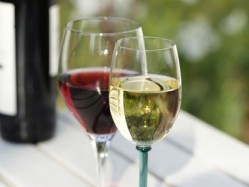Food and drink matching trends: Wine

However, just because wine lists are expected, and wine is a natural match to food, it doesn’t mean operators should just stick a few bottles of best sellers or well-known brands on the list and let them sell themselves.
Matching wines carefully to your food offering and suggesting them to your customers, could not only help you sell more in each area, but, as Russell Dent of the Wine & Spirit Education Trust (WSET) says can better ‘enhance’ a diner’s experience, which will help to bring them back again in the future.
“The idea with food and wine pairing is that one element doesn’t overpower the other,” he says. “The food enhances the wine and the wine enhances the food, so it provides customers with much more of an experience.”
Matching wine to food: the ground rules
So if you want to match your wines effectively to your restaurant's food, where do you start?
If you don’t have the luxury of being able to employ a sommelier in your restaurant, hotel or pub and you have never had any wine training, grappling to understand the key differences in grape varieties, regions and styles can be baffling in itself, let alone keeping up with the latest trends.
However, there are some basic ground rules to follow according to Henry John, marketing manager at 3663’s wine and drinks company Vivas, that simplify the process.
“When it comes to matching wine with food, there are three things to consider; weight, acidity and intensity of both dish and wine, to ensure one doesn’t overpower the other.
“As a general rule of thumb, white wine tends to go with white meat and fish dishes or lighter pastas, whilst reds should be saved for the more robust darker meats. However, matching becomes more complicated when sauces come into play, especially those involving spice.”
For Kathrine Larsen, head sommelier at Orrery the most important factor when choosing a wine to match a dish is to match the body of the wine to the structure of the dish and also consider the aroma of the wine with the dish, so a gourmet beef burger or a steak would ideally need something robust, gutsy and red to accompany it such as an Argentinian Malbec while a fish dish with a creamy sauce may well suit a fruity Chardonnay.
Difficult dishes
As John mentioned previously, there are ingredients, of which spice is one, which are hard to match with wines. With Asian food continuing to rise in popularity, the problem can affect many.
Larsen feels spicy dishes are often better matched with beer, but sometimes recommends a sweeter wine such as a German Kabinett to help round off the edges of the spice.
John believes similar off-dry styles from Alsace can work well with Thai cuisine. "Not a wildly fashionable wine region at the moment, "he says "but definitely one to watch given the rising number of outlets now offering some form of Thai dish on the menu. Alsace makes some of the most interesting and delicious wines from France. A Gewürztraminer or a Gewürztraminer Muscat blend is a clean and crisp wine that has a background of spice balanced with sweet tropical fruit; this would be an excellent partner to a classic such as Thai Green Chicken Curry."
Innovative education
Just as you would educate staff about the food you offer, it is just as important to educate them about the wines you sell so that they in turn are able to talk confidently about what they are selling.
“Wine is sales," says Dent, "The more you know about the subject, the easier it is to communicate and enthuse customers. So staff knowledge is huge.”
Restaurant group TGI Friday's decided to inject some fun into wine training for its staff. It commissioned Vivas to create some Top Trumps style reference cards which feature the wines they sell, the style of wine, suggest a suitable match from the menu (The Furious Boar Merlot with its Jack Daniel's Ribs for example) and some wine facts. Alongside training these have contributed to an increase in wine sales from across the list, rather than staff simply recommending the restaurant's house wines, claims John.
Similarly, businesses could sell more wines by simply promoting them in different ways direct to the customer. Vivas has also worked with Travelodge in its restaurants and has come up with some specific wine pairings to make it easier for diners to veer away from the safe 'house' option and try something different. Meat & Malbec, Pizza & Primitivo and Fish & Fiano now feature as daily promotions as part of the company's strategy to increase spend per head and encourage customers to trade up.
And just helping customers be a little more adventurous can also have a positive effect. "When the guest asks me to recommend a wine, and they have no preferences at all, I ask them if they would like something classic, or something more unusual. Very often they end upgoing for the unusual, and discovering something new," says Larsen.
Keeping up with trends
Ensuring you and your staff members are comfortable talking about the wines you sell and matching them competently with dishes on your menu is more important than following hot new trends. Nevertheless, knowing about trends in the wine world could give your business the edge.
According to wine supplier Enotria, its top performing grape varieties over the past year have been Montepulciano and Cortese, the latter due to a surge in the popularity of the Italian wine Gavi. "What was once very much restricted to Italian restaurants is now a regular on many more diverse lists – it has that chameleon like ability to match with all sorts of bistro type fare as well as typical fish dishes," says Enotria's commercial director John Grieveson.
In red wines, the previously mentioned Malbec is growing strongly as is Barbera and Enotria also predicts that Spanish wines, already popular with customers, will only get more so. Indeed, Larsen, who recently took up her post at Orrery, is looking to include more diversity in the restaurant's Spanish and Italian selections.
Of course, the growing trend in the food world of ensuring ingredients are locally sourced and seasonal, is applicable to wines too. Larsen is looking at lighter wines to introduce onto her wine list as dishes change for the summer and if local produce features heavily on your menu, customers may well be looking for English wines to drink alongside it.
And the quality is improving all the time in this area with English sparkling wine proving it can compete with its French counterparts, so it's not just 'nice to have' says Grieveson.
“Critical acclaim and plenty of positive press have really helped English sparkling wine. English still wines are destined to be more niche but certainly have a place on wine lists too," he says.

































